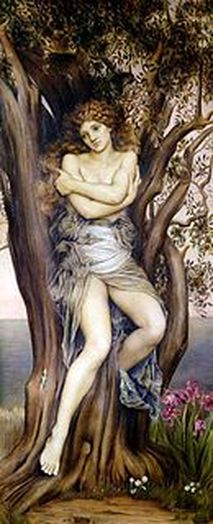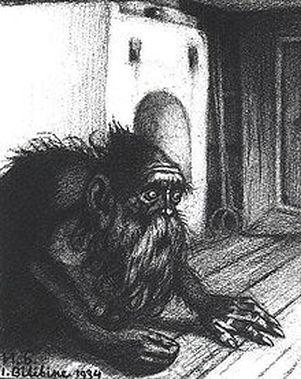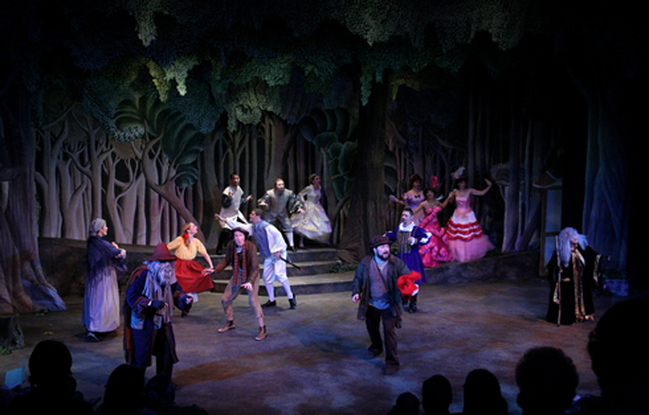|
Amanda C. Davis, co-author of the fairy tale collection Wolves and Witches, shares why one of her favorite fairy-tale retellings works so darn well:
I'm sure Stephen Sondheim and James Lapine's classic 1986 musical Into the Woods wasn't my first twisted fairy tale (that might have been something by Jon Scieszka) but it's the one that made the strongest impression, and it continues to impress me today. The music is complex but catchy. The lyrics are clever. Add a showstopping witch as a villain/plot catalyst/antihero and it's no wonder the thing has seen multiple Tony awards and successful revivals worldwide. As a fairy-tale retelling, I believe Into the Woods succeeds because it does the three things all retellings should: it understands the source material, it remakes it in an insightful way, and it adds its own value. Respect the Source The first line of Into the Woods is "Once upon a time." Its last line is " -- and happily ever after!" (Plus a tiny, tiny coda that sums up the musical's themes. More on that later.) Most of the characters are named for their roles: the Witch, Granny, the Baker's Wife. The first act spins together five separate tales -- one of them invented, but so pitch-perfect that it makes you wonder if you've simply never read it before -- and though they're performed with winks and wry smiles, they're played perfectly straight. The only twist is their combination, which is a pretty clever one, though increasingly common. The first act shows two things: that Sondheim got his inspiration from sources more reliable than Disney movies, and that he understands that the stories are sufficient, without change, to hold an audience's attention. Then the second act happens. Tear It Down Spoilers! It's entirely possible to watch the first act of Into the Woods and quit happy. Sure, there's a called-out "To be continued!" but that act, like the second, ends with " -- happily ever after!" It's a good stopping point for little kids or, perhaps, adults uninterested in shattering a pleasant illusion.
0 Comments
Rhonda Parrish, editor of the highly anticipated Fae anthology, interviews contributor Beth Cato.  What was the inspiration for your Fae story? I wrote my story as part of a Codex Writers' Halloween contest. I was provided two distinct prompts: a luopan, which is a Chinese magnetic compass used in Feng Shui, and lichtenberg figures, the scarring that results from a lightning strike. The luopan put me in mind of maps, and from there I thought--what if there was a map in fractal burns on someone? What would cause that? Was this your first foray into writing fairy stories? No, I've written and published a number of fairy poems and stories, including a steampunk-fae tale "Stitched Wings" for Beneath Ceaseless Skies and a story in the forthcoming B is for Broken anthology. Fairies are such an important part of the fantasy genre, and there are common elements in fairy-like mythologies across the world. It's something universal and accessible. Can you tell us a bit about the specific type of fairy creature in your story? In the case of my story, that would be a major spoiler! I'll withhold the name. The anticipated sequel to Blood Chimera is here and does not disappoint! Jackson Pastor returns in Blood Sin. After writing both novels, Jenn Lyons shares her take on everything from conspiracy theories to humor in serious fiction. Read on for her insightful advice.
Lesson one—write faster than your demons. Jenn Lyons writes 2,000 words an hour in order to leave her brain no time to second-guess itself. She encourages all writers to trust their instincts. Lyons shares four other tips she learned while writing Blood Sin. Find her advice at Chuck Wendig's Terrible Minds. Conspiracy theories—you either love them or hate them. Jenn Lyons personally dislikes conspiracy theories, chalking them up to superstition or ignorance. However, she recognizes her need for these theories for both Blood Sin and its predecessor, Blood Chimera. Why so serious? Even the most serious books at times have a little humor in it. Jenn Lyons discusses the importance of humor in fiction--all kinds of fiction. More praise! Bitten by Books gave Blood Sin a stellar review, calling it “a provocative and terrifying peek into a world unlike any I've visited.” A vampire by any other name... Ever lost at how to categorize a book into a specific genre? What do you name it? Some works blur the lines between these classifications. Blood Sin often does this dance between genres. Yet no matter what the label, it's still just as fun to read. Spice of Life discusses genre in Blood Sin here. "Do you have an alibi?" Detective Alder asks Jackson Pastor. Jenn Lyons imagined an interview between these two characters and shared the results with Bitten by Books. Turns out, Detective Alder drives a tough interrogation, but can he really outdo the wits of Jackson Pastor? Find out here. Rhonda Parrish, editor of the highly anticipated Fae anthology, interviews contributor Kristina Wojtaszek.  What was the inspiration for your Fae story? Solomon's Friend is actually my own very personal story of raising a son with Asperger's. All of Kadie's doubts about herself as a mother are mine; all of Solly's unique views of the world around him are my son's (although not everything Solly does or says in the story are true to life). Hobby, the cantankerous, brash old hob that narrates much of the story, came from an often-ignored voice of my own-- a well of common sense and courage that sparkles every now and again on a quiet, moonlit night, reminding me that I am making some of the right connections with my child, that I am loving him every moment of every day, and that there is still a bit of magic left in the world, especially in the curious and cautious mind of my child. And maybe even in me. |
World Weaver PressPublishing fantasy, paranormal, and science fiction. Archives
February 2024
|
- Home
-
Books
-
All Books
>
- Beyond the Glass Slipper
- Bite Somebody
- Bite Somebody Else
- Black Pearl Dreaming
- Cassandra Complex
- Causality Loop
- Clockwork, Curses, and Coal
- Continuum
- Corvidae
- Cursed: Wickedly Fun Stories
- Dream Eater
- Equus
- Fae
- Falling of the Moon
- Far Orbit
- Far Orbit Apogee
- Fractured Days
- Frozen Fairy Tales
- Glass and Gardens: Solarpunk Summers
- Glass and Gardens: Solarpunk Winters
- Grandmother Paradox
- Grimm, Grit, and Gasoline
- Haunted Housewives
- Heir to the Lamp
- He Sees You When He's Creepin': Tales of Krampus
- Into the Moonless Night
- Jack Jetstark's Intergalactic Freakshow
- King of Ash and Bones (ebook)
- Krampusnacht
- Last Dream of Her Mortal Soul
- Meddlers of Moonshine
- Mothers of Enchantment
- Mrs Claus
- Multispecies Cities
- Murder in the Generative Kitchen
- Recognize Fascism
- Scarecrow
- Sirens
- Shards of History
- Shattered Fates
- Skull and Pestle
- Solarpunk (Translation)
- Solarpunk Creatures
- Solomon's Bell
- SonofaWitch!
- Speculative Story Bites
- Trenchcoats, Towers, and Trolls
- Weredog Whisperer
- Wolves and Witches
- Anthologies and Collections
- Novels
- Novellas
- Fairy Tale
- Fantasy
- Romance
- Science Fiction
- Urban/Contemporary Fantasy
- Young Adult SFF
-
All Books
>
- Blog
- About
- Contact
- Press / Publicity
- Newsletter Signup
- Privacy Policy
- Store



 RSS Feed
RSS Feed